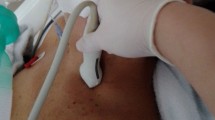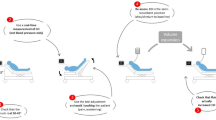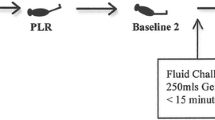Abstract
Purpose
We performed a systematic review and meta-analysis of studies investigating the passive leg raising (PLR)-induced changes in cardiac output (CO) and in arterial pulse pressure (PP) as predictors of fluid responsiveness in adults.
Methods
MEDLINE, EMBASE and Cochrane Database were screened for relevant original and review articles. The meta-analysis determined the pooled area under the ROC curve, the sensitivity, specificity and threshold for the PLR test when assessed with CO and PP.
Results
Twenty-one studies (991 adult patients, 995 fluid challenges) were included. CO was measured by echocardiography in six studies, calibrated pulse contour analysis in six studies, bioreactance in four studies, oesophageal Doppler in three studies, transpulmonary thermodilution or pulmonary artery catheter in one study and suprasternal Doppler in one study. The pooled correlation between the PLR-induced and the fluid-induced changes in CO was 0.76 (0.73–0.80). For the PLR-induced changes in CO, the pooled sensitivity was 0.85 (0.81–0.88) and the pooled specificity was 0.91 (0.88–0.93). The area under the ROC curve was 0.95 ± 0.01. The best threshold was a PLR-induced increase in CO ≥10 ± 2 %. For the PLR-induced changes in PP (8 studies, 432 fluid challenges), the pooled sensitivity was 0.56 (0.49–0.53), the pooled specificity was 0.83 (0.77–0.88) and the pooled area under the ROC curve was 0.77 ± 0.05. Sensitivity and subgroup analysis were consistent with the primary analysis.
Conclusions
PLR-induced changes in CO very reliably predict the response of CO to volume expansion in adults with acute circulatory failure. When PLR effects are assessed by changes in PP, the specificity of the PLR test remains acceptable but its sensitivity is poor.




Similar content being viewed by others
References
Lira A, Pinsky MR (2014) Choices in fluid type and volume during resuscitation: impact on patient outcomes. Ann Intensive Care 4:38
Marik PE, Monnet X, Teboul JL (2011) Hemodynamic parameters to guide fluid therapy. Ann Intensive Care 1:1
Dellinger RP, Levy MM, Rhodes A, Annane D, Gerlach H, Opal SM, Sevransky JE, Sprung CL, Douglas IS, Jaeschke R, Osborn TM, Nunnally ME, Townsend SR, Reinhart K, Kleinpell RM, Angus DC, Deutschman CS, Machado FR, Rubenfeld GD, Webb S, Beale RJ, Vincent JL, Moreno R (2013) Surviving sepsis campaign: international guidelines for management of severe sepsis and septic shock, 2012. Intensive Care Med 39(2):165–228
Cecconi M, De Backer D, Antonelli M, Beale R, Bakker J, Hofer C, Jaeschke R, Mebazaa A, Pinsky MR, Teboul JL, Vincent JL, Rhodes A (2014) Consensus on circulatory shock and hemodynamic monitoring. Task force of the European Society of Intensive Care Medicine. Intensive Care Med 40:1795–1815
Dellinger RP, Levy MM, Rhodes A, Annane D, Gerlach H, Opal SM, Sevransky JE, Sprung CL, Douglas IS, Jaeschke R, Osborn TM, Nunnally ME, Townsend SR, Reinhart K, Kleinpell RM, Angus DC, Deutschman CS, Machado FR, Rubenfeld GD, Webb SA, Beale RJ, Vincent JL, Moreno R (2015) Updated bundles in response to new evidence. In: Surviving sepsis campaign. http://www.survivingsepsis.org/sitecollectiondocuments/ssc_bundle.pdf (in press)
Monnet X, Teboul JL (2015) Passive leg raising: five rules, not a drop of fluid! Crit Care 19:18
Boulain T, Achard JM, Teboul JL, Richard C, Perrotin D, Ginies G (2002) Changes in BP induced by passive leg raising predict response to fluid loading in critically ill patients. Chest 121:1245–1252
Monnet X, Teboul JL (2013) Assessment of volume responsiveness during mechanical ventilation: recent advances. Crit Care 17:217
Monnet X, Rienzo M, Osman D, Anguel N, Richard C, Pinsky MR, Teboul JL (2006) Passive leg raising predicts fluid responsiveness in the critically ill. Crit Care Med 34:1402–1407
Cavallaro F, Sandroni C, Marano C, La Torre G, Mannocci A, De Waure C, Bello G, Maviglia R, Antonelli M (2010) Diagnostic accuracy of passive leg raising for prediction of fluid responsiveness in adults: systematic review and meta-analysis of clinical studies. Intensive Care Med 36:1475–1483
Duus N, Shogilev DJ, Skibsted S, Zijlstra HW, Fish E, Oren-Grinberg A, Lior Y, Novack V, Talmor D, Kirkegaard H, Shapiro NI (2015) The reliability and validity of passive leg raise and fluid bolus to assess fluid responsiveness in spontaneously breathing emergency department patients. J Crit Care 30(217):e211–e215
Dong ZZ, Fang Q, Zheng X, Shi H (2012) Passive leg raising as an indicator of fluid responsiveness in patients with severe sepsis. World J Emerg Med 3:191–196
Kupersztych-Hagege E, Teboul JL, Artigas A, Talbot A, Sabatier C, Richard C, Monnet X (2013) Bioreactance is not reliable for estimating cardiac output and the effects of passive leg raising in critically ill patients. Br J Anaesth 111:961–966
Silva S, Jozwiak M, Teboul JL, Persichini R, Richard C, Monnet X (2013) End-expiratory occlusion test predicts preload responsiveness independently of positive end-expiratory pressure during acute respiratory distress syndrome. Crit Care Med 41:1692–1701
Monge Garcia MI, Gil Cano A, Gracia Romero M, Monterroso Pintado R, Perez Madueno V, Diaz Monrove JC (2012) Non-invasive assessment of fluid responsiveness by changes in partial end-tidal CO2 pressure during a passive leg-raising maneuver. Ann Intensive Care 2:9
Guinot PG, Zogheib E, Detave M, Moubarak M, Hubert V, Badoux L, Bernard E, Besserve P, Caus T, Dupont H (2011) Passive leg raising can predict fluid responsiveness in patients placed on veno–venous extracorporeal membrane oxygenation. Crit Care 15:R216
Monnet X, Bataille A, Magalhaes E, Barrois J, Le Corre M, Gosset C, Guerin L, Richard C, Teboul JL (2013) End-tidal carbon dioxide is better than arterial pressure for predicting volume responsiveness by the passive leg raising test. Intensive Care Med 39:93–100
Monnet X, Bleibtreu A, Ferré A, Dres M, Gharbi R, Richard C, Teboul JL (2012) Passive leg raising and end-expiratory occlusion tests perform better than pulse pressure variation in patients with low respiratory system compliance. Crit Care Med 40:152–157
Brun C, Zieleskiewicz L, Textoris J, Muller L, Bellefleur JP, Antonini F, Tourret M, Ortega D, Vellin A, Lefrant JY, Boubli L, Bretelle F, Martin C, Leone M (2013) Prediction of fluid responsiveness in severe preeclamptic patients with oliguria. Intensive Care Med 39:593–600
Marik PE, Levitov A, Young A, Andrews L (2013) The use of bioreactance and carotid Doppler to determine volume responsiveness and blood flow redistribution following passive leg raising in hemodynamically unstable patients. Chest 143:364–370
Lakhal K, Ehrmann S, Runge I, Benzekri-Lefevre D, Legras A, Dequin PF, Mercier E, Wolff M, Regnier B, Boulain T (2010) Central venous pressure measurements improve the accuracy of leg raising-induced change in pulse pressure to predict fluid responsiveness. Intensive Care Med 36:940–948
Benomar B, Ouattara A, Estagnasie P, Brusset A, Squara P (2010) Fluid responsiveness predicted by noninvasive bioreactance-based passive leg raise test. Intensive Care Med 36:1875–1881
Kang WS, Kim SH, Kim SY, Oh CS, Lee SA, Kim JS (2014) The influence of positive end-expiratory pressure on stroke volume variation in patients undergoing cardiac surgery: an observational study. J Thorac Cardiovasc Surg 148:3139–3145
Whiting PF, Rutjes AW, Westwood ME, Mallett S, Deeks JJ, Reitsma JB, Leeflang MM, Sterne JA, Bossuyt PM, Group Q (2011) QUADAS-2: a revised tool for the quality assessment of diagnostic accuracy studies. Ann Intern Med 155:529–536
Tautz TJ, Urwyler A, Antognini JF, Riou B (2010) Case scenario: increased end-tidal carbon dioxide: a diagnostic dilemma. Anesthesiology 112:440–446
Weil MH, Bisera J, Trevino RP, Rackow EC (1985) Cardiac output and end-tidal carbon dioxide. Crit Care Med 13:907–909
Conway DH, Hussain OA, Gall I (2013) A comparison of noninvasive bioreactance with oesophageal Doppler estimation of stroke volume during open abdominal surgery: an observational study. Eur J Anaesthesiol 30(8):501–508
Fagnoul D, Vincent JL, Backer DD (2012) Cardiac output measurements using the bioreactance technique in critically ill patients. Crit Care 16:460
Monnet X, Teboul JL (2015) Minimally invasive monitoring. Crit Care Clin 31:25–42
Zamora J, Abraira V, Muriel A, Khan K, Coomarasamy A (2006) Meta-DiSc: a software for meta-analysis of test accuracy data. BMC Med Res Methodol 6:31
Lafanechère A, Pène F, Goulenok C, Delahaye A, Mallet V, Choukroun G, Chiche JD, Mira JP, Cariou A (2006) Changes in aortic blood flow induced by passive leg raising predict fluid responsiveness in critically ill patients. Crit Care 10(5):R132
Lamia B, Ochagavia A, Monnet X, Chemla D, Richard C, Teboul JL (2007) Echocardiographic prediction of volume responsiveness in critically ill patients with spontaneously breathing activity. Intensive Care Med 33:1125–1132
Thiel SW, Kollef MH, Isakow W (2009) Non-invasive stroke volume measurement and passive leg raising predict volume responsiveness in medical ICU patients: an observational cohort study. Crit Care 13:R111
Monnet X, Osman D, Ridel C, Lamia B, Richard C, Teboul JL (2009) Predicting volume responsiveness by using the end-expiratory occlusion in mechanically ventilated intensive care unit patients. Crit Care Med 37:951–956
Biais M, Vidil L, Sarrabay P, Cottenceau V, Revel P, Sztark F (2009) Changes in stroke volume induced by passive leg raising in spontaneously breathing patients: comparison between echocardiography and Vigileo/FloTrac device. Crit Care 13:R195
Preau S, Saulnier F, Dewavrin F, Durocher A, Chagnon JL (2010) Passive leg raising is predictive of fluid responsiveness in spontaneously breathing patients with severe sepsis or acute pancreatitis. Crit Care Med 38:989–990
Maizel J, Airapetian N, Lorne E, Tribouilloy C, Massy Z, Slama M (2007) Diagnosis of central hypovolemia by using passive leg raising. Intensive Care Med 33:1133–1138
Guérin L, Teboul JL, Persichini R, Dres M, Richard C, Monnet X (2015) Effects of passive leg raising and volume expansion on mean systemic pressure and venous return in shock in humans. Crit Care 19:411. doi:10.1186/s13054-015-1115-2
Mahjoub Y, Pila C, Friggeri A, Zogheib E, Lobjoie E, Tinturier F, Galy C, Slama M, Dupont H (2009) Assessing fluid responsiveness in critically ill patients: false-positive pulse pressure variation is detected by Doppler echocardiographic evaluation of the right ventricle. Crit Care Med 37:2570–2575
Malbrain ML, Reuter DA (2010) Assessing fluid responsiveness with the passive leg raising maneuver in patients with increased intra-abdominal pressure: be aware that not all blood returns! Crit Care Med 38:1912–1915
Monnet X, Teboul JL (2010) Passive leg raising: keep it easy! Intensive Care Med 36:1445–1446
Mahjoub Y, Touzeau J, Airapetian N, Lorne E, Hijazi M, Zogheib E, Tinturier F, Slama M, Dupont H (2010) The passive leg-raising maneuver cannot accurately predict fluid responsiveness in patients with intra-abdominal hypertension. Crit Care Med 38:1824–1829
Monnet X, Letierce A, Hamzaoui O, Chemla D, Anguel N, Osman D, Richard C, Teboul JL (2011) Arterial pressure allows monitoring the changes in cardiac output induced by volume expansion but not by norepinephrine*. Crit Care Med 39:1394–1399
Pierrakos C, Velissaris D, Scolletta S, Heenen S, De Backer D, Vincent JL (2012) Can changes in arterial pressure be used to detect changes in cardiac index during fluid challenge in patients with septic shock? Intensive Care Med 38:422–428
Jabot J, Teboul JL, Richard C, Monnet X (2009) Passive leg raising for predicting fluid responsiveness: importance of the postural change. Intensive Care Med 35:85–90
Marik PE (2014) Early management of severe sepsis: concepts and controversies. Chest 145:1407–1418
Prowle JR, Kirwan CJ, Bellomo R (2014) Fluid management for the prevention and attenuation of acute kidney injury. Nat Rev Nephrol 10:37–47
Jozwiak M, Silva S, Persichini R, Anguel N, Osman D, Richard C, Teboul JL, Monnet X (2013) Extravascular lung water is an independent prognostic factor in patients with acute respiratory distress syndrome. Crit Care Med 41:472–480
Marik PE (2013) Noninvasive cardiac output monitors: a state-of the-art review. J Cardiothorac Vasc Anesth 27:121–134
Muller L, Toumi M, Bousquet PJ, Riu-Poulenc B, Louart G, Candela D, Zoric L, Suehs C, de La Coussaye JE, Molinari N, Lefrant JY (2011) An increase in aortic blood flow after an infusion of 100 ml colloid over 1 minute can predict fluid responsiveness: the mini-fluid challenge study. Anesthesiology 115:541–547
Hamzaoui O, Monnet X, Richard C, Osman D, Chemla D, Teboul JL (2008) Effects of changes in vascular tone on the agreement between pulse contour and transpulmonary thermodilution cardiac output measurements within an up to 6-hour calibration-free period. Crit Care Med 36:434–440
Squara P, Denjean D, Estagnasie P, Brusset A, Dib JC, Dubois C (2007) Noninvasive cardiac output monitoring (NICOM): a clinical validation. Intensive Care Med 33:1191–1194
Marque S, Cariou A, Chiche JD, Squara P (2009) Comparison between Flotrac–Vigileo and bioreactance, a totally noninvasive method for cardiac output monitoring. Crit Care 13:R73
Author information
Authors and Affiliations
Corresponding author
Ethics declarations
Conflicts of interest
Jean-Louis Teboul and Xavier Monnet are members of the Medical Advisory Board of Maquet. They are the authors of the majority of the studies included in this meta-analysis. Paul E Marik has no conflicts to disclose.
Additional information
Take-home message: In this meta-analysis of 21 studies including 991 adult patients in whom 995 fluid challenges were performed, total, we found that the changes in cardiac output induced by a passive leg raising test are highly reliable in predicting fluid responsiveness. When its effects were assessed by changes in arterial pulse pressure, the specificity of passive leg raising remains good but its sensitivity is poor.
Electronic supplementary material
Below is the link to the electronic supplementary material.
Rights and permissions
About this article
Cite this article
Monnet, X., Marik, P. & Teboul, JL. Passive leg raising for predicting fluid responsiveness: a systematic review and meta-analysis. Intensive Care Med 42, 1935–1947 (2016). https://doi.org/10.1007/s00134-015-4134-1
Received:
Accepted:
Published:
Issue Date:
DOI: https://doi.org/10.1007/s00134-015-4134-1




